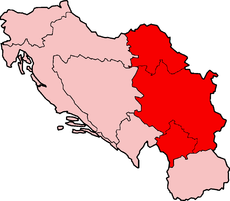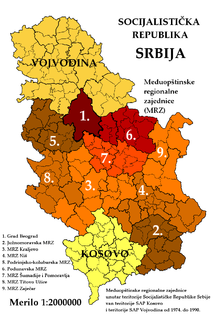- Socialist Republic of Serbia
-
Socijalistička Republika Srbija
Социјалистичка Република Србија
Socialist Republic of SerbiaA federal unit of the
Socialist Federal Republic of Yugoslavia← 
←
←
←
1943 — 1990  →
→

Flag Coat of arms 
Capital Belgrade Official language Serbo-Croatian (eastern variant)
(Hungarian, Slovak, Romanian, Rusyn co-official in SAP Vojvodina; Albanian co-official in SAP Kosovo)Established
In the SFRY:
- Since
- Until1943
January 31, 1946
September 28, 1990Area
- Total
- WaterRanked 1st in the SFRY
88,361 km²
0.13%Population
- Total
- DensityRanked 1st in the SFRY
9,506,174
114.0/km²Currency Yugoslav dinar (динар, dinar) Time zone UTC + 1 Socialist Republic of Serbia (Serbo-Croatian: Socijalistička Republika Srbija, Социјалистичка Република Србија) was a socialist state that was a constituent country of the Socialist Federal Republic of Yugoslavia. It is a predecessor of modern day Serbia, which served as the biggest republic in the Yugoslav federation and held the largest population of all the Yugoslav republics, and it housed the greatest concentration of economical and political development in the Socialist Federal Republic of Yugoslavia as its capital Belgrade was also the federal capital of Yugoslavia.
Contents
History
From 1945 to 1963, the republic was officially known as People's Republic of Serbia (Narodna Republika Srbija), and from 1963 to 1990 as Socialist Republic of Serbia (Socijalistička Republika Srbija). The republic was controversially internally divided in 1974 to include two autonomous provinces, Vojvodina and Kosovo which had the same rights and privileges as constituent republics of Yugoslavia.
For most of its existence in the SFRY, Serbia was loyal and generally subordinate to the federal government. This changed after the death of Josip Broz Tito in 1980 and the rise of Albanian as well as Serbian nationalism in Kosovo, which resulted in a split in the League of Communists on how to respond. A successful round of coups in the Communist party leadership of Serbia as well as Montenegro occurred from 1988 to 1989, led by Slobodan Milošević who supported Serbian nationalists in Kosovo in removing Kosovo's autonomy.
In 1989, Milošević became President of the republic and demanded that the federal Yugoslav government act for the interests of Serbia in Kosovo by sending in the Yugoslav Peoples Army to take control of the province. Opposition to such action and the demands by Serbia for a "one-member, one-vote" system in the Yugoslav League of Communists, which would have given a majority of votes to Serbs, precipitated ethnic tensions and the collapse of the League of Communists of Yugoslavia and of Yugoslavia itself by 1991.
After 1990, the state was known simply as Republic of Serbia (Republika Srbija) which was a constituent republic in the rump Federal Republic of Yugoslavia, then as Serbia and Montenegro until 2006 when Serbia became an independent state.
Administrative divisions
Within Socialist Republic of Serbia two autonomous provinces existed: Socialist Autonomous Province of Vojvodina and Socialist Autonomous Province of Kosovo. The central part of the Socialist Republic of Serbia located outside of the two autonomous provinces was generally known as "Serbia proper" ("Uža Srbija").
Demographics
1971 census
In 1971, total population of the Socialist Republic of Serbia numbered 8,446,591 people, including:
- Serbs = 6,142,071 (72.71%)
- Albanians = 984,761 (11.66%)
- Hungarians = 430,314 (5.10%)
- Croats = 184,913 (2.19%)
- Muslims = 154,330 (1.83%)
- Yugoslavs = 123,824 (1.47%)
- Slovaks = 76,733
- Romanians = 57,419
- Bulgarians = 53,800
- Roma = 49,894
- Macedonians = 42,675
- Rusyns = 20,608
- Turks = 18,220
- Slovenes = 15,957
- Vlachs = 14,724
1981 census
In 1981, total population of the Socialist Republic of Serbia numbered 9,313,677 people, including:
- Serbs = 6,331,527 (67.96%)
- Albanians = 1,303,032 (13.99%)
- Yugoslavs = 441,941 (4.75%)
- Hungarians = 390,468 (4.19%)
- Muslims = 215,166 (2.31%)
- Croats = 149,368 (1.60%)
- Roma = 110,956 (1.19%)
- Macedonians = 48,986
- Slovenes = 12,006
Politics
In the Socialist Republic, the only legal political party was the League of Communists of Serbia (Savez komunista Srbije), which was part of the League of Communists of Yugoslavia. The party remained relatively stable and loyal to the federal party until the late 1980s, when the party became split over what action to take in Kosovo when protests and fights broke out between ethnic Albanians and Serbs.
The more traditional Communists supported President Ivan Stambolic advocated continued neutrality as a means to solve the dispute while more radical and nationalist-leaning members supported Slobodan Milosevic advocated the protection of Kosovo's Serbs who had claimed that their population was being pressured to leave Kosovo by Albanian separatists. Milosevic utilized public sentiment and opposition to Kosovo separatism to rally large numbers of supporters to help him overthrow the Communist leadership in Vojvodina, Kosovo and the Socialist Republic of Montenegro in what was known as the anti-bureaucratic revolution. Afterwards, the Serbian League of Communists selected Milosevic as their leader. Milosevic took a hard stand on Albanian nationalism in Kosovo and pressured the Yugoslav government to give him emergency powers to deal with Kosovo separatists. Furthermore he reduced the autonomy of the autonomous provinces of Kosovo and Vojvodina and installed politicians loyal to him to serve as their representatives.
In the congress of the Yugoslav League of Communists in 1990, Milosevic and his subordinate representatives for Vojvodina, Kosovo and the Socialist Republic of Montenegro attempted to silence opposition from the Socialist Republic of Slovenia which opposed the actions taken against Kosovo by blocking all reforms proposed by the Slovene representatives. The tactic failed and Slovenia, along with its ally Croatia, abdicated from the Yugoslav Communist Party. This caused the Yugoslav Communist party to fall apart, and then the state of Yugoslavia itself one year later.
Heads of institutions
Chairman of ASNOS (1944 - 1945)
- Siniša Stanković (12 November 1944 - 7 April 1945)
History of Serbia 
This article is part of a seriesBy century 9th · 10th Prehistory Starčevo · Vinča · Scordisci · Triballi Roman (Illyria; Moesia · Pannonia · Dacia) Middle Ages Principality (768-969) (Rascia · Doclea · Zachlumia · Travunia · Pagania) Catepanate · Theme (969–1043) Vojislavljević Doclea (998–1101) Grand Principality (1101–1217) Kingdom (1217–1346) Empire (1346–1371) Fall · Lazar's Serbia (1371–1402) Despotate (1402–1459) Early modern Ottoman (1402–1912) Habsburg Kingdom of Serbia (1718–1739) Great Serb Migrations Modern Serbia Revolution (1804–1815) Principality of Serbia (1817–1882) Kingdom of Serbia (1882–1918) Yugoslavia (1918–1990/2006) German Occupation (1941–1944) Socialist Republic (1944–1990) Federal Republic, then State Union (1990–2006) Republic of Serbia (since 2006) Timeline
Serbia Portal
Presidents
- President of the Presidium of the People's Assembly (1945 - 1953)
- Siniša Stanković (7 April 1945 - March 1953)
- Presidents of the National Assembly (1953 - 1974)
- Petar Stambolić (December 1953 - April 1957)
- Jovan Veselinov (April 1957 - 26 June 1963)
- Dušan Petrović (26 June 1963 - 6 May 1967)
- Miloš Minić (6 May 1967 - 6 May 1969)
- Dragoslav Marković (6 May 1969 - 19 April 1974)
- Živan Vasiljević (19 April - 6 May 1974)
- Presidents of the Presidency (1974 - 1990)
- Dragoslav Marković (6 May 1974 - 5 May 1978)
- Dobrivoje Vidić (5 May 1978 - 5 May 1982)
- Nikola Ljubičić (5 May 1982 - 5 May 1984)
- Dušan Čkrebić (5 May 1984 - 5 May 1986)
- Ivan Stambolić (5 May 1986 - 14 December 1987)
- Petar Gračanin (14 December 1987 - 20 March 1989)
- Ljubiša Igić (20 March - 8 May 1989) (acting)
- Slobodan Milošević (8 May 1989 - 28 September 1990)
Prime Ministers
- Minister for Serbia in Yugoslav government
- Jaša Prodanović (7 March 1945 - 9 April 1945
- President of the Government
- Blagoje Nešković (9 April 1945 - 5 September 1948)
- Petar Stambolić (5 September 1948 - 5 February 1953)
- President of the Executive Council
- Petar Stambolić (5 February 1953 - 16 December 1953)
- Jovan Veselinov (16 December 1953 - 6 April 1957)
- Miloš Minić (6 April 1957 - 9 June 1962)
- Slobodan Penezić Krcun (9 June 1962 - 6 November 1964)
- Stevan Doronjski (Acting; 6 November 1964 - 17 November 1964)
- Dragi Stamenković (17 November 1964 - 6 June 1967)
- Đurica Jojkić (6 June 1967 - 7 May 1969)
- Milenko Bojanić (7 May 1969 - 6 May 1974)
- Dušan Čkrebić (6 May 1974 - 6 May 1978)
- Ivan Stambolić (6 May 1978 - 5 May 1982)
- Branislav Ikonić (5 May 1982 - 6 May 1986)
- Desimir Jevtić (6 May 1986 - 5 December 1989)
- Stanko Radmilović (5 December 1989 - 28 September 1990)
See also
Socialist republics and socialist autonomous provinces of the Socialist Federal Republic of Yugoslavia SR Bosnia and Herzegovina · SR Croatia · SR Macedonia · SR Montenegro · SR Serbia (SAP Kosovo · SAP Vojvodina) · SR Slovenia
Categories:- 1943 establishments
- 1990 disestablishments
- History of Serbia
- Yugoslav Serbia
- Socialist Republic of Serbia
- Second Yugoslavia
- Subdivisions of Yugoslavia
- Former Slavic countries
Wikimedia Foundation. 2010.

